Jonah Hill True Story
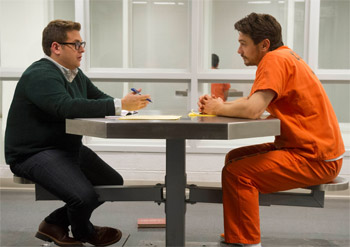
Jonah Hill True Story
Cast: James Franco, Jonah Hill, Felicity Jones
Director: Rupert Goold
Genre: Drama, Mystery, Thriller
Rated: R
Running Time: 104 minutes
Synopsis: When disgraced New York Times reporter Michael Finkel (Jonah Hill) meets accused killer Christian Longo (James Franco) – who has taken on Finkel's identity – his investigation morphs into an unforgettable game of cat-and-mouse. Based on actual events, Finkel's relentless pursuit of Longo's true story encompasses murder, love, and deceit.
True Story
About the Production
February of 2002 marked a turning point in the life of New York Times reporter Michael Finkel. Riding high as one of the paper's busiest and most peripatetic journalists, he was instantly shot down when it was revealed that he had tampered with the truth in a New York Times Magazine cover story he had written on contemporary slave trading in Africa. The New York Times quickly showed Michael Finkel the door, and he watched his world collapse.
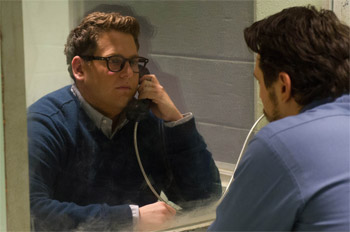 His life almost immediately took another twist; he'd become a victim of identity theft. Nobody had stolen his social security or credit card numbers, but someone had assumed his name and was posing as him in Mexico; Christian Longo, a man who had just been apprehended and accused of murdering his own wife and children.
His life almost immediately took another twist; he'd become a victim of identity theft. Nobody had stolen his social security or credit card numbers, but someone had assumed his name and was posing as him in Mexico; Christian Longo, a man who had just been apprehended and accused of murdering his own wife and children.
Charming, articulate, and appealing, Christian Longo was the last person anyone would have suspected of such crimes. During the months of incarceration that preceded his trial, he insisted there was only one individual to whom he would tell his story: the reporter whose name he'd stolen. For Michael Finkel, the offer became an irresistible scoop, a way to start rebuilding his shattered reputation--and ultimately, a Faustian bargain.
Michael Finkel's experience was clearly a unique one, the fodder for the most uncompromising kind of self-reckoning. It caused him to question himself, his choice of career, and his own moral and ethical code. Longo offered him a chance at personal and professional redemption. Reflecting on Michael Finkel's dilemma, Jonah Hill says, 'I think, in situations where you're trying to resurrect yourself, you believe that there's possibility in anything that presents itself that might help you out."
By the same token, the inner journey of Christian Longo, a seemingly normal young man who could suddenly murder his entire family, brought James Franco face-to-face with a human being few of us could even begin to understand. 'In some ways Longo is unreadable," said James Franco during filming, 'but unreadable with a hint of friendliness, of charm. The way he reacts to things doesn't add up to what we know about him, or what we find out about him. That's why it's so eerie and ambiguous"because he doesn't seem connected to what he did; to what is happening around him; to his punishment."
After killing his wife, Mary Jane, and their three children in December 2001, he fled to Mexico, where he was ultimately tracked down and apprehended two months later. Longo now sits on Death Row, where he has been spearheading a campaign for condemned prisoners to be allowed to donate their body parts to those who are medically in need of them.
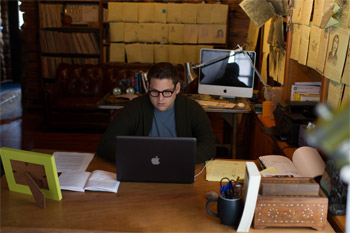 Genesis Of True Story
Genesis Of True Story Following his New York Times dismissal, Michael Finkel planned to hide out from the world in his home base just outside of Bozeman, Montana. But Christian Longo's capture under Finkel's name opened an utterly unexpected chapter in Finkel's life.
What followed became the basis for Finkel's memoir True Story, which was published by HarperCollins to rave reviews in 2005. Booklist called it 'absolutely riveting, as much for Finkel's own painful self-examination as for the evasions of an accused murderer." Publishers Weekly, in its starred review, said it was 'astute and hypnotically absorbing…there's a burning sincerity and beautifully modulated writing on every page."
Plan B producers Jeremy Kleiner and Dede Gardner read True Story when it was published and were immediately struck by it, seeing in it the potential for a gripping film. 'We found the story to be extremely disturbing. It is obviously a tragedy – and the way that Michael Finkel's personal journey intersects with that tragedy conjured bigger themes about the nature of evil, ambition, and the price of success and failure," they say.
Screenwriter David Kajganich worked on the script for years. Rupert Goold then became interested in the project – and working from David Kajanich's script - Goold shaped and molded it further. 'Rupert's instincts about the material were phenomenal," says Jeremy Kleiner. 'Maybe it's because he's not American, and sees this from a different perspective. He saw that there was something about ambition, the fear of failure, and what happens to people psychologically when they feel like a failure. Plus he was especially clear from the very beginning that the material had to be highly visual. And if you watch his filmed theatrical performances of Macbeth or Richard II, then you know he brings enormous visual flair to the material."
When Plan B heads Brad Pitt, Dede Gardner and Jeremy Kleiner sent Jonah Hill the True Story book and script to read, asking him to consider playing Mike Finkel, Hill was instantly intrigued by the material. 'I found the story to be incredibly shocking"and really, really sad," he says. 'It was interesting to see how these two people dealt with each other in the face of all this"the bad things they did, and how they relate to each other. They are two very flawed guys who are trying to both resurrect themselves and play each other. It's a story that happened in the U.S., but I think people everywhere are going to understand and relate to it."
The relationship between Mike Finkel and Christian Longo is tentative at first – strangely, they are similar in many ways: two people in search of notoriety, brought together by choice and circumstance.
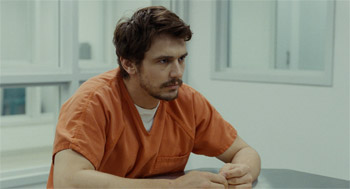 According to Goold, there is an additional layer to the relationship between Finkel and Longo. 'At heart," he says, 'I think I was also interested in the idea of a nemesis, that all of us in our lives, particularly at that point, particularly men--young men--tend to find somebody. They often seek out somebody, who becomes their great rival, or the kind of person by whom they measure themselves in competition.
According to Goold, there is an additional layer to the relationship between Finkel and Longo. 'At heart," he says, 'I think I was also interested in the idea of a nemesis, that all of us in our lives, particularly at that point, particularly men--young men--tend to find somebody. They often seek out somebody, who becomes their great rival, or the kind of person by whom they measure themselves in competition. Felicity Jones agrees. 'I think it's very much like a romantic relationship. Mike and Longo do almost fall in love with each other, in a strange way. One moment Mike thinks he can trust Longo, and then Longo will do something that changes it all. Longo is a challenge for him. As for Jill, at first she just doesn't want to even know about it; it feels alien to her that her partner would want to become so involved with a man who's murdered his wife and children. But she is flawed in her own way, just as Mike is. She permits it to happen, and she becomes fascinated with Longo and has her own projections onto him, and you become aware that they're both intoxicated by him."
Longo, who remains in Oregon on Death Row, did not participate in the film as the filmmakers never solicited his involvement.
Although the prison interviews between Mike Finkel and Christian Longo are major scenes, they were not part of the rehearsal process beyond the first initial table read. According to Jonah Hill, 'James Franco and I both felt we wanted to go into the room together for the first time and do the scenes for the first time on film because they're supposed to feel authentic. We shot them in continuity order, so you really feel the initial awkwardness and then you see the relationship progress from there." For two actors who already knew each other well as colleagues and friends, it was an effective method of sweeping away the familiarity and the comfort level that they had reached over the years.
The Characters' Evolution
The process of making True Story was much like that of any other movie, but all three key actors admitted that it weighed heavily on them. 'I've made three dramas that are based on real stories, playing real characters," says Jonah Hill, 'and none of them have been more heartbreaking or heavy than this. You just feel an immense responsibility at all times to make sure that you're being respectful to the people that this actually happened to and that were affected." It was not easy for him to let go of all of this at the end of each day. 'I think when you're making a comedy or a drama, anything, you kind of take the atmosphere of what you're doing home with you in some way. When I was making 21 Jump Street I was having fun and the set was fun, so I would go home and be in a good mood. For this, where I was spending all day every day thinking about something so devastating"something that really happened--it was almost impossible to snap out of it."
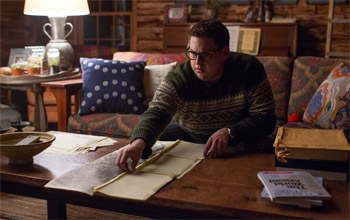 It was leagues away from the playful, outrageous comedy This Is The End, the previous film in which he had appeared with James Franco. 'To go from a very broad comedy like that to this kind of movie--which is probably the polar opposite"well, it was really interesting to get to do two movies of such different tones with the same actor. And, you know, James Franco and I have a tendency to joke around with one another, but on a movie like this you just can't. You really can't."
It was leagues away from the playful, outrageous comedy This Is The End, the previous film in which he had appeared with James Franco. 'To go from a very broad comedy like that to this kind of movie--which is probably the polar opposite"well, it was really interesting to get to do two movies of such different tones with the same actor. And, you know, James Franco and I have a tendency to joke around with one another, but on a movie like this you just can't. You really can't." 'I was talking to Jonah Hill about this yesterday," said James Franco during the filming of one of the prison sequences. 'Because my character is so irredeemable, and because part of his spookiness is that on the surface he appears nice and charming, I feel a little icky being around other people between shots. I feel like I am being extra nice and I don't know if they see this as some sort of rub-off from the character. I shudder at being connected too closely with him. Fortunately, Rupert Goold and Jonah Hill and the whole crew behind the camera are all very, very kind. So this could have been an incredibly miserable experience just because it is so dark. But having Jonah Hill and Rupert Goold and such a terrific crew does make it a lot easier."
Jonah Hill is also quick to credit Rupert Goold with providing a sense of support during this not-altogether-pleasant production period. 'Of course," he laughs, 'Rupert Goold is very British, which I'm not used to, and there were a lot of times when it was me, him, and Felicity Jones, and she's also British, so I was like the odd American out. But Rupert Goold is so smart, he's so interesting, he cares about the performances and the tone of what you're doing so much. He's very visual, but he's also very actor-centric, as many theater directors are, and of course that's great for the actors. I just think the guy's so talented, and he cares so much and he's so involved in every nuance of the scene. It was a joy to be around him and work with him. I think this movie's really going to let people here in America know who he is."
Locations And Filming
The eight-year gestation of the film version of True Story finally came to fruition when principal photography began in Warwick, NY on March 8, 2013. Although only a few days' worth of the film's action takes place in New York City"specifically the scenes in and around The New York Times offices"the decision was made to film entirely in New York state. The woods and farmland outside of Warwick stood in for Montana, while coastal Oregon was played by numerous small towns within an hour's driving distance of New York, including Piermont, Sparkill, Bayville, and Port Jefferson. (One day of filming also took place in Cancun for the sequence depicting Christian Longo's arrest in Mexico.)
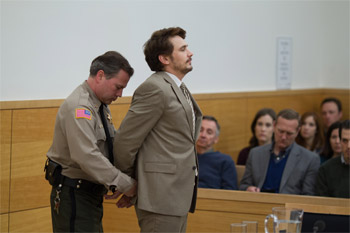 In addition to snowy exteriors, Warwick also was the location for the Montana home of Jill and Mike. A kind of contemporary log cabin with spacious, open-planned interiors, it was ideal for filming. The company spent eight days there. 'I think the most challenging thing was probably to wrap our heads around how to do Montana in New York," says production designer Jeremy Hindle. 'Trying to find exteriors and a cabin was going to be really tricky, but then it finally worked out." To add authenticity to the cabin interiors, Jeremy Hindle found trinkets and souvenirs of the sort that Finkel used to bring back from his trips all over the world, and Finkel himself contributed a box or two of his personal belongings and work-related paraphernalia. 'Jill has very little space in that house," says Jeremy Hindle. 'Most of it is Mike's. It's his space. It's his art. It's his world. It's his office and she has this little nook in the corner; a piano area; a knitting area. And she lives there all year and he's traveling around the world. But it's Mike, who does dominate the space."
In addition to snowy exteriors, Warwick also was the location for the Montana home of Jill and Mike. A kind of contemporary log cabin with spacious, open-planned interiors, it was ideal for filming. The company spent eight days there. 'I think the most challenging thing was probably to wrap our heads around how to do Montana in New York," says production designer Jeremy Hindle. 'Trying to find exteriors and a cabin was going to be really tricky, but then it finally worked out." To add authenticity to the cabin interiors, Jeremy Hindle found trinkets and souvenirs of the sort that Finkel used to bring back from his trips all over the world, and Finkel himself contributed a box or two of his personal belongings and work-related paraphernalia. 'Jill has very little space in that house," says Jeremy Hindle. 'Most of it is Mike's. It's his space. It's his art. It's his world. It's his office and she has this little nook in the corner; a piano area; a knitting area. And she lives there all year and he's traveling around the world. But it's Mike, who does dominate the space." The film also shot in New York City itself. The glass-walled office where Finkel is questioned and ultimately fired by his two editors was actually filmed in the New York Times building on Eighth Avenue and 41st Street, though not in The New York Times' offices. The large, atrium-styled bullpen where Mike works, a spectacularly visual space, was part of John Jay College on New York's far west side. The reading that Mike gives at the end of the film was shot in the popular, historic Rizzoli bookstore on West 57th Street, a landmark townhouse that, unfortunately, has since been demolished.
The prison scenes were filmed at numerous locations. One was in a series of abandoned quarters at a jail facility in Kew Gardens, Queens. Another was a new penitentiary located in Goshen, New York. Its long, sterile white hallways were perfect for the scene in which Mike first visits Longo. Longo's cell, and the visiting room where they have their meetings, were all designed by Hindle and built at the JC Studios in Brooklyn, where the company spent its final week of filming.
It was important to Rupert Goold and to costume designer Cat Thomas that attention be paid to Christian Longo's overall look and appearance. Thomas admits that can be a difficult task with an actor who possesses the film-star looks of James Franco. One solution was the drab, monochromatic, buff-colored suit that Longo wears in the trial scenes. 'We talked a lot about the color of the suit," says Cat Thomas, 'and, you know, it's probably the closest to the reality of what Longo actually wore in real life. We liked it; it makes him a little washed out. There's something kind of off about it."
Spending eight weeks in this world of unexplained, unfathomable evil can be an experience that is difficult for any actor to shake. And according to Michael Finkel, 'The story never ends with Chris Longo." More than ten years after the fact, Longo is still in Finkel's life, for better or worse. 'Sometimes a year will go by where there's silence," says Finkel, 'and then there'll be a relative flurry of phone calls. And usually if there's been a long silence and then the phone rings, and I see the Caller ID and I know it's from the Oregon State Penitentiary, there's this very uncomfortable sort of static, like: 'Do I want to pick up this phone?"
True Story
MORE
- Mission: Impossible Fallout
- Glenn Close The Wife
- Allison Chhorn Stanley's Mouth Interview
- Benicio Del Toro Sicario: Day of the Soldado
- Dame Judi Dench Tea With The Dames
- Sandra Bullock Ocean's 8
- Chris Pratt Jurassic World: Fallen Kingdom
- Claudia Sangiorgi Dalimore and Michelle Grace...
- Rachel McAdams Disobedience Interview
- Sebastián Lelio and Alessandro Nivola...
- Perri Cummings Trench Interview



